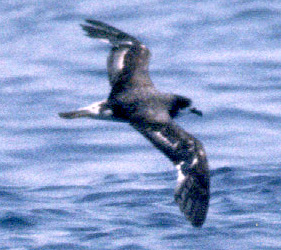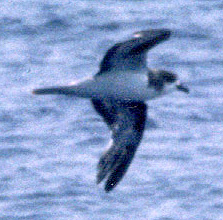Bermuda Petrel Pterodroma cahow
Gulf Stream off Oregon Inlet, North Carolina
2 June 2000
Joseph Morlan
Photographs © 2 June 2000 by Martin Myers.
 Robbie Fischer and I were passengers
aboard the Country Girl on one of Brian Patteson's
pelagic trips. The voyage had been quite successful with excellent viewing conditions and relatively calm seas.
By about 2pm, most of the regular species were in high numbers but no significant rarities had been seen. The skipper
announced that the boat would be returning to port soon. Suddenly whales were announced over the public address
system. I was on the right forward side of the boat where we had excellent views of at least two Cuvier's Beaked
Whales. While enjoying these small whales, Peter Fraser from Cornwall, England called out, "What's this?"
He then started choking out the words "Cahow!" I got on the bird immediately as it headed right in toward
the boat, banking close down the right side, circling the stern and flying up the left side giving everybody excellent
views of this rarely seen bird. It made another pass near the boat as Brian Patteson announced "Bermuda Petrel"
before the bird headed forward and away.
Robbie Fischer and I were passengers
aboard the Country Girl on one of Brian Patteson's
pelagic trips. The voyage had been quite successful with excellent viewing conditions and relatively calm seas.
By about 2pm, most of the regular species were in high numbers but no significant rarities had been seen. The skipper
announced that the boat would be returning to port soon. Suddenly whales were announced over the public address
system. I was on the right forward side of the boat where we had excellent views of at least two Cuvier's Beaked
Whales. While enjoying these small whales, Peter Fraser from Cornwall, England called out, "What's this?"
He then started choking out the words "Cahow!" I got on the bird immediately as it headed right in toward
the boat, banking close down the right side, circling the stern and flying up the left side giving everybody excellent
views of this rarely seen bird. It made another pass near the boat as Brian Patteson announced "Bermuda Petrel"
before the bird headed forward and away.
The "Country Girl" is an unusually fast boat. The skipper gunned the engines, and ran the boat full
 bore, overtaking the Bermuda Petrel
at least three times. He tried to adjust the speed to keep the bird with the boat, but the petrel slowed and we
past the bird several times. Eventually the bird got away from us, but not until everybody on board had very satisfying
views.
bore, overtaking the Bermuda Petrel
at least three times. He tried to adjust the speed to keep the bird with the boat, but the petrel slowed and we
past the bird several times. Eventually the bird got away from us, but not until everybody on board had very satisfying
views.
The following is a description of the bird.
A medium-sized light Pterodroma superficially similar to Black-capped Petrel (Pterodroma hasitata)
many of which had been seen during the trip. It was slightly smaller than Black-capped Petrel, with a noticeably
smaller bill. When Black-capped Petrels came in close to the boat, I was impressed by their massive sculptured
bill. I specifically looked at the Bermuda Petrel's bill and felt it was much less deep and smaller overall.
The most obvious difference between the Bermuda Petrel and the Black-capped, was the head pattern. Both species
showed a white forehead, but on the Black-capped Petrels, the dark cap came down through the eye and then receded
on the side of the nape, usually forming a wide white collar around the back of the head. On the Bermuda Petrel,
the black cap blended with the dark gray of the back and nape coming down on the side of the breast in a uniform
straight line before curving up to meet the mantle. Thus the head pattern recalled that of Dark-rumped Petrel (Pterodroma
phaeopygia) more than Black-capped.
The upperparts were dark with white spotting visible at the bases of the secondaries and some primaries. These
were pale feather shafts made visible because many of the greater wing coverts had been molted and were missing.
Most of the Black-capped Petrels showed a similar pattern of heavy molt.
The rump was mostly dark, but the uppertail coverts were white forming an indistinct, narrow band of mottled
white. This band blended gradually with the long dark gray tail and did not contrast sharply as in the Black-capped
Petrels.
The underparts were white, with a broad black carpal bar extending along the leading edge of the outer underwing
and angling back toward the axillaries. I also got the impression of some dusky flecking on the secondaries as
the bird banked toward us. The underwing was similar to that of Black-capped Petrel but seemed overall more heavily
marked and darker.
The bird flew in the graceful style of Black-capped Petrel, gliding up on bowed wings and seldom flapping. In
discussion with others, most felt that the bird was shorter winged and longer tailed than Black-capped Petrel,
but this was a subtle distinction and not particularly obvious.
Discussion
The Bermuda Petrel is one of North America's rarest birds with only about 200 individuals believed to reside
on islets off Bermuda. The 7th edition of the AOU Checklist (1998) states that there are no confirmed records away
from the breeding grounds, but "sightings have been reported off North Carolina." The species was recently
added to the American Birding Association Checklist (Birding 31:518-524, 1999) based on individuals photographed
off North Carolina 26 May 1996, 29 May 1998 (Field Notes 52:408, 1998) and 16 August 1999. The official
North Carolina Bird Checklist indicates that
there is one accepted record of Bermuda Petrel with two more pending.
Additional information on Bermuda Petrel's status is provided by Birdlife
International and at Angus Wilson's site. The standard
reference on identification and distribution is
Wingate, D. B., Hass, T., Brinkley, E. S., and Patteson, J. B. (1998) Identification of Bermuda Petrel. Birding
30: p18-36.
A copy of this paper was available aboard the boat and was instrumental in convincing the skeptics among us
that we had really seen this almost mythical bird.
Several excellent photographs taken in past years have been posted at Brian
Patteson's site. A Bermuda Petrel was also seen well and photographed on May
26th and seen briefly on May 27th. An account of these trips has been posted here.
Comparing the molt pattern evident in the photos by Martin Myers, posted above with those posted by Patteson show
that our bird was almost certainly the same individual. Another Bermuda Petrel was seen June 3rd out of Manteo
by the Focus on Nature tour, but no photos were obtained. It was said to be in fresh plumage, and thus definitely
a different bird from the earlier sightings (Paul Guris pers.comm).
Martin Meyers has posted a more
detailed account of our trip on Birdchat. Additional commentary on identification by Macklin
Smith and Gail
Mackiernan can be found there and very helpful information on variation in Black-capped Petrel has been posted
by Todd McGrath.
 bore, overtaking the Bermuda Petrel
at least three times. He tried to adjust the speed to keep the bird with the boat, but the petrel slowed and we
past the bird several times. Eventually the bird got away from us, but not until everybody on board had very satisfying
views.
bore, overtaking the Bermuda Petrel
at least three times. He tried to adjust the speed to keep the bird with the boat, but the petrel slowed and we
past the bird several times. Eventually the bird got away from us, but not until everybody on board had very satisfying
views. Robbie Fischer and I were passengers
aboard the Country Girl on one of Brian Patteson's
pelagic trips. The voyage had been quite successful with excellent viewing conditions and relatively calm seas.
By about 2pm, most of the regular species were in high numbers but no significant rarities had been seen. The skipper
announced that the boat would be returning to port soon. Suddenly whales were announced over the public address
system. I was on the right forward side of the boat where we had excellent views of at least two Cuvier's Beaked
Whales. While enjoying these small whales, Peter Fraser from Cornwall, England called out, "What's this?"
He then started choking out the words "Cahow!" I got on the bird immediately as it headed right in toward
the boat, banking close down the right side, circling the stern and flying up the left side giving everybody excellent
views of this rarely seen bird. It made another pass near the boat as Brian Patteson announced "Bermuda Petrel"
before the bird headed forward and away.
Robbie Fischer and I were passengers
aboard the Country Girl on one of Brian Patteson's
pelagic trips. The voyage had been quite successful with excellent viewing conditions and relatively calm seas.
By about 2pm, most of the regular species were in high numbers but no significant rarities had been seen. The skipper
announced that the boat would be returning to port soon. Suddenly whales were announced over the public address
system. I was on the right forward side of the boat where we had excellent views of at least two Cuvier's Beaked
Whales. While enjoying these small whales, Peter Fraser from Cornwall, England called out, "What's this?"
He then started choking out the words "Cahow!" I got on the bird immediately as it headed right in toward
the boat, banking close down the right side, circling the stern and flying up the left side giving everybody excellent
views of this rarely seen bird. It made another pass near the boat as Brian Patteson announced "Bermuda Petrel"
before the bird headed forward and away.